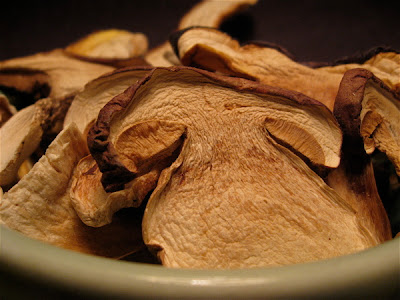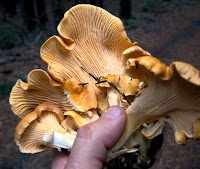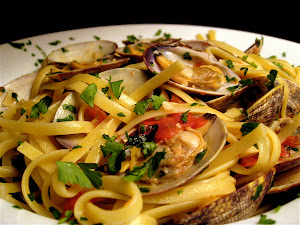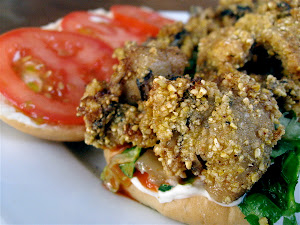
This post goes out to my dear reader in Augusta, Italy, where the value of “little pigs” is understood.
I’m a fan of secret ingredients—just as long as I’m in on the gig. Secret ingredients can be exotic, hard to find, or, as in this case, curveballs. For two years running now, maybe longer, the Puget Sound Mycological Society‘s annual exhibit has employed a certain chef to whip up countless mushroom dishes for its cooking demonstrations, including a wonderful Cream of Chanterelle Soup. This year I collared the cook during a moment of weakness and extracted the recipe. The secret ingredient that puts this soup over the top is not the nutmeg (although the spice adds an extra dimension for sure) and it’s not the chanterelles, as velvety smooth and sweet as they are (a secret ingredient can’t be the main ingredient, after all). No, the secret ingredient in this chanterelle soup is an entirely different species of mushroom that lifts the soup out of mere excellence and raises it to the sublime: Boletus edulis, the king bolete—known to Italians as porcini, or “little pigs.” The porcini have been dried and aged to concentrate the flavor, then pulverized into dust before being reconstituted in warm water. The resulting wet mush is like a double-shot of the earth itself.
Italians have enjoyed the hearty properties of porcini for centuries. They use them to flavor soups, stews, and sauces with an earthy bass note that cannot be duplicated with any other ingredient, fungal or otherwise. King boletes fruit throughout the temperate regions of the world, although we are fortunate in the American West to have a noteworthy abundance while in traditional European hunting grounds the king, like many other mushroom species (including chanterelles) is increasingly hard to find. Spruce forests in particular are places to look. The largest concentrations of king boletes I’ve ever encountered have been in the montane forests of Colorado. Yesterday’s Cream of Chanterelle Soup was made with king boletes from the North Cascades and chanterelles from Oregon’s Rogue River Canyon. Ideally the chanties should be fresh out of the woods; frozen chanterelles such as these are acceptable provided they’ve been properly stored. The last time I made this soup, for the annual Yakima River Burning Pram, a buxom fly-fisher who called herself Trout Girl took a spoonful and asked me if I was married. Such is the magic of this fairly simple recipe.
Cream of Chanterelle Soup
6 tbsp butter
1 med onion, diced
1 lb fresh chanterelles, diced (frozen dry-sauteed is acceptable; see this post)
1 – 3 oz. dried porcini, rehydrated in 1/2 – 1 cup hot water
1/4 cup flour
4 cups beef stock
1/4 tsp white pepper
1/8 tsp ground nutmeg
salt to taste
1 1/2 – 2 cups heavy cream
1. Melt butter in large pot. Add onions and cook over medium heat until caramelized.
2. Add chanterelles, raise heat, cook 5 minutes, stirring.
3. Pulverize porcini into dust with food processor and rehydrate.
4. Blend in flour with sauteed mushrooms and onions. Add stock slowly. Add porcini mush and any leftover water.
5. Bring to boil, reduce to simmer 5 minutes. Add spices.
6. Lower heat and add cream.
Serves 4 – 6

Like this:
Like Loading...
 NEVER WAS A show-stopper so easy to prepare. Linguini with Clams, or Pasta alle Vongole in Italian, has the hallmarks of a classic dish: fresh shellfish glistening atop a feathery bed of pasta with accents of red tomato and green parsley to draw the eye.
NEVER WAS A show-stopper so easy to prepare. Linguini with Clams, or Pasta alle Vongole in Italian, has the hallmarks of a classic dish: fresh shellfish glistening atop a feathery bed of pasta with accents of red tomato and green parsley to draw the eye.





